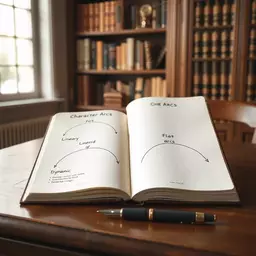Character Arcs Explained Simply
By Clara Eastwood / Nov 11
Character arcs are the essence of storytelling, capturing our hearts and minds through the evolution of characters. They are what make a narrative compelling and relatable, and understanding them can elevate any writer's craft. So, let's explore the key insights that will enhance your storytelling journey!
Understanding the different types of character arcs is crucial for crafting compelling narratives. Below are the key types of character arcs represented visually. For more in-depth exploration, consider creating compelling character arcs in your next story.
Characters undergo transformation and growth, learning valuable lessons through challenges. Examples include:
Protagonists remain consistent in their beliefs, influencing others without personal transformation. Notable examples:
These arcs depict a decline or regression, exploring darker themes through characters' choices. Key insights include:
Tailoring character arcs to different genres enhances storytelling. Considerations include:
Character arcs are more than just a narrative framework; they are the beating heart of storytelling! When crafted well, these arcs help your characters evolve in ways that resonate with readers. At Fiction Frameworks, I believe that understanding character arcs is crucial for any fiction writer looking to create compelling narratives.
So, what exactly is a character arc? In essence, it's the transformation or journey a character undergoes throughout a story. This journey can involve growth, decline, or even a consistent stay in their beliefs and behaviors. Let's dive deeper into why character arcs matter.
Character arcs aren't just about what characters do; they reflect their internal struggles and changes. If a character starts as selfish but becomes selfless, their arc becomes a powerful story of growth. Here are core concepts that highlight their importance:
A character arc represents the transformation a character experiences throughout the narrative. This can be a positive change, a negative descent, or a flat arc where the character remains consistent. Understanding these types is vital for writers because it helps shape the character's journey and the story's outcome.
In my experience, the best arcs are those that feel genuine and relatable! Whether your character is a hero or an anti-hero, their journey should reflect realistic emotions and struggles that draw readers in. To learn more about how character arcs enhance storytelling depth, visit our article on character arcs and storytelling depth.
Character arcs matter because they create a roadmap for your character's development. Think of them as the guiding star for your narrative. When readers see a character grow or struggle, they become invested in their success or failure. This emotional investment fuels the tension and excitement of the story!
Moreover, well-crafted character arcs can make a story memorable. When I write, I always consider how a character’s journey can resonate on multiple levels. This approach not only enhances the reading experience but also ensures the story stays with readers long after they’ve turned the last page.
Character arcs are not one-size-fits-all! Instead, you can categorize them into different types based on their trajectories. Let's break them down into three main categories: positive arcs, flat arcs, and negative arcs.
Positive character arcs showcase a journey of growth and transformation. Characters evolve through challenges, learning valuable lessons along the way. Here are some examples of positive arcs in popular media:
When it comes to crafting your own characters, think about how they can transform in meaningful ways. Just like in my courses at Fiction Frameworks, focusing on character growth can help shape a compelling narrative!
Not all characters need to change! Flat character arcs feature protagonists who remain consistent in their beliefs and traits. These characters can effect change in others even without undergoing personal transformation. Here's a quick overview of notable flat arcs:
Flat arcs can be just as compelling as transformative arcs! They provide a contrast that highlights the growth of secondary characters or the story's world. Writers should not underestimate the power of a strong, consistent character!
Negative character arcs depict a journey of decline or regression. These arcs can explore darker themes, showcasing how characters can fall into conflict due to their choices. Here are key insights into negative arcs:
Negative arcs are powerful tools to showcase the consequences of poor choices. They remind us that every decision has a ripple effect, making them essential in storytelling. Just like I emphasize in my writing workshops, understanding these arcs adds depth to your characters! For those looking to master plotting, effective plotting tools for writers can provide additional support.
When crafting your character arcs, consider creating a character arc worksheet. This can help you outline your character's initial state, key turning points, and their final transformation. By visualizing the arc, you can ensure that each character's journey feels cohesive and impactful!
Here are some common questions writers have about character arcs:
As we dive into the world of storytelling, it's clear that effective character arcs are foundational to crafting compelling narratives. Understanding how to shape these arcs can greatly enhance your writing. From considering how characters evolve to the emotional journeys they embark on, there’s so much to reflect on! By summarizing these key elements, we can better appreciate their significance in creating stories that resonate.
To start, let’s address the importance of tailoring character arcs to different genres. Each genre has unique expectations and tropes that influence how characters should develop. Whether you’re writing a romance, a thriller, or a fantasy epic, adapting your character arcs to fit these conventions can elevate your story's impact. Here are some genre-specific considerations to keep in mind:
Now, let’s explore some common questions writers have about character arcs. Many aspiring authors often wonder how to ensure their character’s journey feels authentic and satisfying. Understanding these elements can help you navigate the complexities of character development. Here are a few frequently asked questions:
Incorporating narrative techniques like foreshadowing and symbolism can further enhance the depth of your character arcs. These techniques allow you to lay groundwork for transformations and create emotional resonance. For instance, using symbols like a character’s recurring dream or an heirloom can signify their inner struggles and growth. Here’s how you can effectively apply these techniques:
As you refine your skills in crafting character arcs, remember that continuous learning is vital. Utilizing resources like those from Fiction Frameworks can greatly assist you in your journey. We provide various tools and templates designed to simplify character development and enhance storytelling clarity. Whether you're just starting or looking to polish your writing, there's always a way to grow! For example, consider starting your first novel together with our guidance.
For those eager to dive deeper, here are some resources to explore:
In closing, remember that character arcs are a crucial component of storytelling. They not only drive your plot forward but also create connections with your readers. So, as you sit down to write your next story, reflect on your characters’ journeys. How will they change? What will they learn? Take action today and start crafting your character's journey—your story deserves it! Explore more on character arcs in novels explained.
Let’s keep the conversation going! Share your thoughts or questions about character arcs, and together we can unlock the potential of your storytelling journey at Fiction Frameworks. Happy writing!
Here is a quick recap of the important points discussed in the article:

 Character Arcs Explained Simply
Every compelling story resonates with readers because of the evolution of its characters. Whether it
Character Arcs Explained Simply
Every compelling story resonates with readers because of the evolution of its characters. Whether it
 Outline Your Novel with Templates
Have you ever been stuck staring at a blank page, unsure of where to start? Outlining your novel can
Outline Your Novel with Templates
Have you ever been stuck staring at a blank page, unsure of where to start? Outlining your novel can
 Plotting Fiction: Strategies That Work
Did you know that a well-structured plot can make the difference between a reader putting your book
Plotting Fiction: Strategies That Work
Did you know that a well-structured plot can make the difference between a reader putting your book